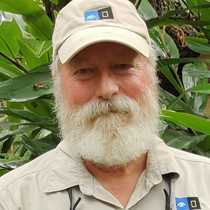Hornsund, Spitsbergen Island, Svalbard
Early this morning, National Geographic Explorer reached dense pack ice off the southern end of Spitsbergen, the largest island in the Svalbard Archipelago. It was great fun pushing and crunching our way through the floes, watching for marine life along the way. Several groups of harp seals were spotted swimming among the ice chunks, and countless guillemots, little auks, fulmars, and kittiwakes were flitting about, as well. The weather conditions were nearly perfect and we enjoyed bright sunshine, blue skies, white ice floes, and beautiful views of the snow-covered mountains in the distance, cloaked by some amazing clouds (Figure A).
By early afternoon, we reached the mouth of Hornsund, a large fjord system in the southwestern region of Spitsbergen Island and spent the rest of the day exploring the finger-like waterways of its interior. There was plenty of thin, flat sea ice to play with in the sound. It was good to be here early in the season so we could still encounter plenty of fast ice, that is ice that is attached to the shore, but most of it had already broken loose and was floating free as ice floes. With their geometric shapes, the ice floes were reminiscent of pieces of a giant jigsaw puzzle (Figure B). In addition, we also encountered a few impressive massive icebergs that had calved off some of the glaciers within Hornsund.
With the present conditions, we enjoyed spectacular scenery, but there was one thing on everyone’s mind…polar bears. We saw many tracks, both on the ice floes and the snow-covered shore line, but alas, no bears were sighted today. We did, however, see numerous other forms of wildlife, including myriad seabirds that nest on the steep slopes of some of the surrounding islands, as well as ringed seals and bearded seals hauled out on ice. But, the highlight of the afternoon wildlife viewing was unquestionably a tight-knit pod of beluga whales. These strange, but graceful creatures were moving quickly along the shore, so we were able to follow along with them at a safe distance and get excellent views of them as they continually rolled at the surface. These small whales are truly Arctic animals and are beautifully adapted for survival in icy waters. This particular pod contained perhaps 15 individuals and since we could identify several young animals among them, we figured this group most likely consisted of just mothers and their calves. Males usually form separate pods during this time of year and wouldn’t normally be associating with calves.
We sailed back out of Hornsund by early evening and headed for the steep drop-off about 20 nautical miles from the western shore of Spitsbergen. We knew from experience that this is a region where the giant baleen whales hang out to feed on the rich supply of plankton and small, schooling fishes. As expected, several whales were sighted when we reached the area just after dinner. Timing was no problem, because the sun was still high over the horizon and we had plenty of light. The first whale was identified as a fin whale, second only to the mighty blue whale in size, and soon numerous other whales were seen in the distance and they needed to be checked out before we continued on a northerly course toward our next destination. As a matter of interest, all the whales we found here at the drop-off were fin whales.




